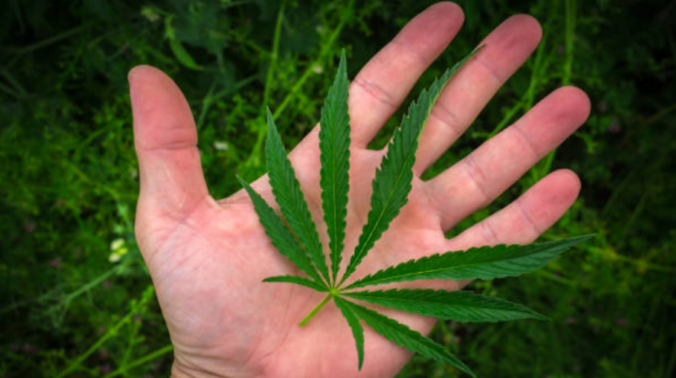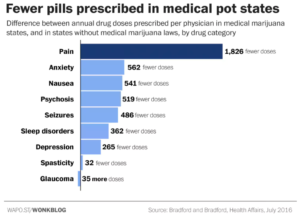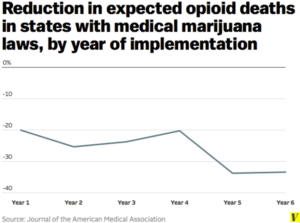Recent studies have shown that people in the U.S. are increasingly turning to medical marijuana to treat a variety of health issues, and that could spell big trouble for Big Pharma. Twenty-eight states and Washington D.C. have now passed medical marijuana legislation. Across these legal markets, prescriptions for pharmaceuticals have been consistently declining in categories where cannabis or cannabis-derived medicines exist. Here’s a look at what kind of impact this will have on Big Pharma if the trend continues.
Older Americans are Choosing Cannabis
In a 2016 study1, University of Georgia researchers Ashley Bradford and W. David Bradford looked at the number of prescriptions written for Medicare patients to determine if marijuana legalization had impacted pharmaceutical prescription fill rates. They considered nine conditions for which cannabis is commonly prescribed and shown to be effective:
- Chronic pain
- Post-traumatic stress disorder (PTSD)
- Sleep disorders
- Anxiety
- Epilepsy
- Nerve pain
- Chemotherapy-induced nausea and vomiting
- Tourette Syndrome
- Glaucoma
The researchers found that pharmaceutical prescription writing decreased when cannabis-derived medicines were available to patients. For example, in states without medical marijuana, the average physician prescribed 2,068 doses of prescription medication for spasticity; whereas, in states with medical marijuana, the prescription rate dropped by 20 percent to 1,645 doses. Other conditions also saw decreases in prescriptions:
- Anxiety: 10%
- Depression: 7.5%
- Nausea: 10%
- Pain: 8.7%
- Psychosis: 10%
- Seizures: 6.9%
- Sleep Disorders: 12.3%
The average reduction in pharmaceutical prescriptions across all conditions studied was 11 percent, indicating that cannabis is working for older Americans.
By providing access to medical marijuana, states are also saving Medicare a substantial amount of money on patient health bills.
A look at the years 2010-2013 shows that savings in Medicare and out-of-pocket spending for the 17 states (and the District of Columbia) that had legalized marijuana access at the time reached into the hundreds of millions:
- 2010: $104.5 million
- 2011: $114.9 million
- 2012: $130.5 million
- 2013: $165.2 million
That may not seem like a lot when compared to the overall amount spent on pharmaceutical medications, but older Americans aren’t the only ones choosing cannabis over pharmaceuticals.
Other Americans are Choosing Cannabis, Too
Building on their previous research, the same researcher duo published an additional study in April 20172, but this time the focus was on Medicaid spending. Unlike Medicare, which only covers America’s elderly population, Medicaid covers low-income people of all ages. This study looked at prescriptions filled for the same conditions during a longer period, from 2007-2014. The decrease in prescriptions filled for pharmaceutical medications in states with access to medical marijuana held true and fell by even higher percentages.
- Anti-nausea drug prescriptions declined by 17%.
- Antidepressant drug prescriptions decreased by 13%.
- Seizure and psychosis drug prescriptions fell by 12%.
The researchers concluded that, if every state had legalized medical marijuana in 2014, Medicaid savings could have reached $1.01 billion.
The $18 Billion Impact of Choosing Medical Marijuana Over Big Pharma
Another research firm, New Frontier Data out of Washington D.C., decided to take the research one step further. They estimated how many billions Big Pharma stands to lose3 if every state legalized cannabis use. The results are astounding.
Keeping the focus on the same nine conditions outlined by the National Academies of Science as those effectively treated by cannabis, New Frontier Data estimates that Americans will spend $168.34 billion on prescriptions from 2016-2019. This projection is based on an estimate of $40.09 billion in sales for 2016 with forecasted growth to over $44.1 billion in 2019.
Keeping the average decrease rate of 11 percent shown in Bradfords original study and assuming legalized access to medical cannabis in every state, the reduction in money spent on pharmaceuticals would be:
- $4.41 billion in 2016
- $4.55 billion in 2017
- $4.70 billion in 2018
- $4.86 billion in 2019
The result is a combined saving of $18.5 billion over the four-year period. If the reduction rises to an average of 14 percent, as the Bradfords found in their more recent Medicaid study, the impact to Big Pharma could be as high as $23.57 billion.
Given these numbers, it’s not difficult to see why Big Pharma is so opposed to medical marijuana legalization. Any industry that stands to lose an average of 11-14 percent of their sales would be. The threat from medical cannabis is particularly acute for companies such as Pfizer, which manufactures medications for at least five of the nine4 conditions studied.
It’s also not surprising that Big Pharma is actively looking to produce their own cannabinoid-based medicines. Take the case of Insys Therapeutics, maker of the fentanyl-based oral spray, Subsys. Insys was far and away the largest financial supporter of the campaign to oppose cannabis legalization in Arizona, contributing more than $500,000. That funding was a significant factor in defeating the initiative in November. Flash forward six months, and in May 2017 Insys announced that they had received FDA approval on Syndros, a cannabinoid-derived oral spray for the treatment of nausea and vomiting.
Cannabis research is an evolving field, but it is becoming apparent that medical marijuana can provide a better alternative to many patients who don’t want to take the pharmaceutical route. Medical marijuana patients, on the whole, are saving money on healthcare and achieving better results.
Given the restrictions that have hindered cannabis research for so long in this country, it’s fair to assume that we are just scratching the surface of our understanding of the benefits of cannabinoid-based medicine. Big Pharma should be concerned and take note of the impact cannabis-derived medications are having on the industry and the health of the people that they profess to help.
References:
1 Ashley Bradford and W. David Bradford, July 2016
Health Affairs, Medical Marijuana Laws Reduce Prescription Medication Use in Medicare Part D.
http://content.healthaffairs.org/content/35/7/1230.full
2 Ashley Bradford and W. David Bradford, April 2017.
Health Affairs, Medical Marijuana Laws May Be Associated with A Decline in The Number of Prescriptions for Medicaid Enrollees.
http://content.healthaffairs.org/content/early/2017/04/13/hlthaff.2016.1135
3 New Frontier Data,
Medical Cannabis Could Take a Big Bite Out of Pharmaceutical Sales.
https://newfrontierdata.com/marijuana-insights/medical-cannabis-take-big-bite-pharmaceutical-sales/
4 Alicia Wallace, May 24, 2017.
The Cannabist, Report: Medical marijuana could poach more than $4B from pharma sales annually
http://www.thecannabist.co/2017/05/24/medical-marijuana-pharmaceutical-sales-impact/80045/



